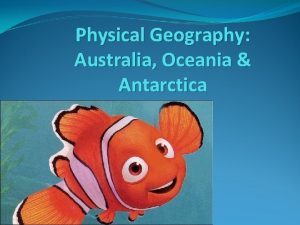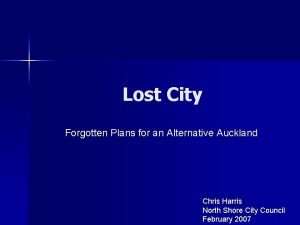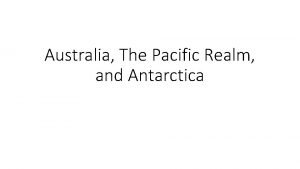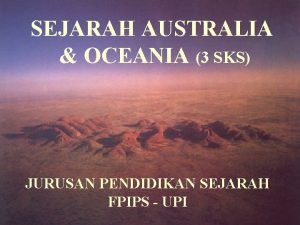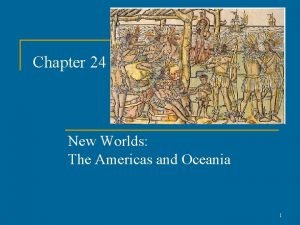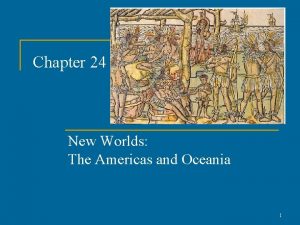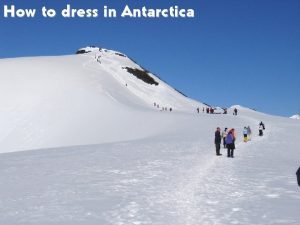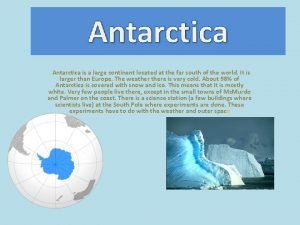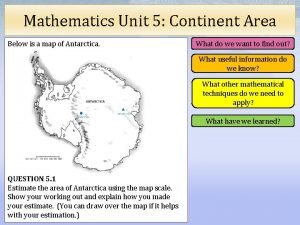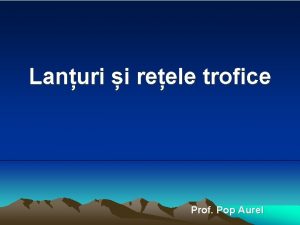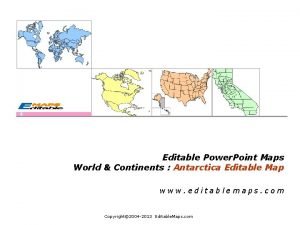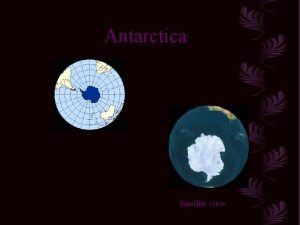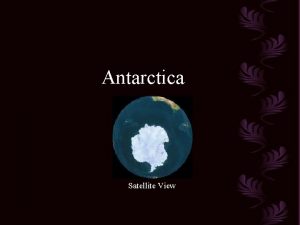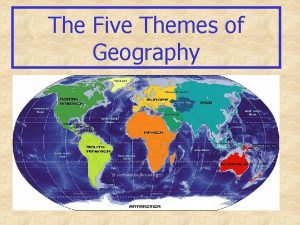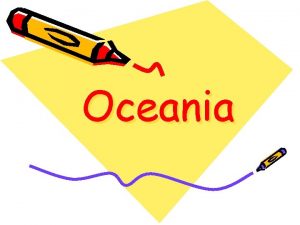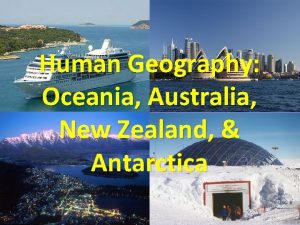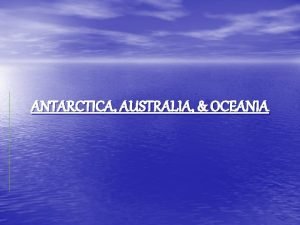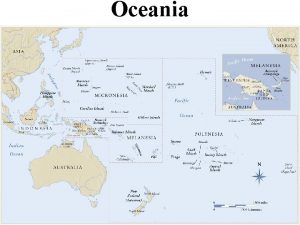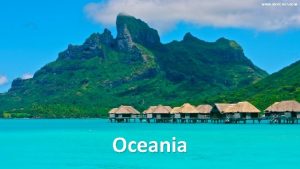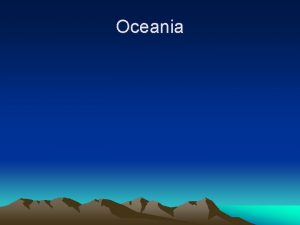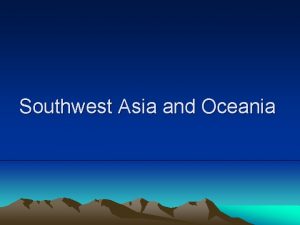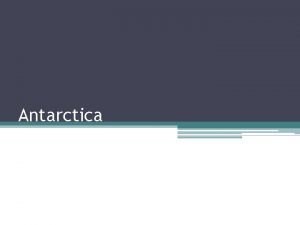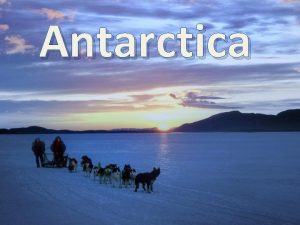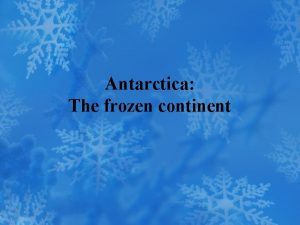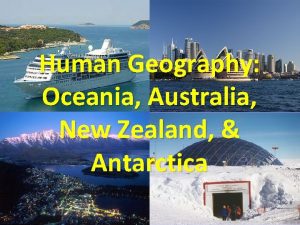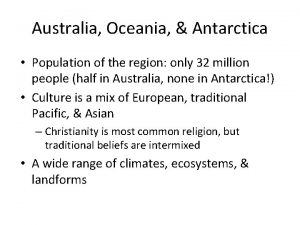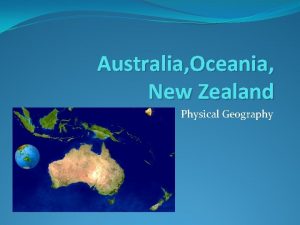Oceania New Zealan d Australia Antarctica Unit 8


















- Slides: 18

Oceania, New Zealan d, Australia, & Antarctica Unit 8 Worl d Geography

What is the dominant climate for Oceania, Australia, New Zealand, and Antarctica?

Oceania 0 No one knows how many islands exist in the Pacific Ocean, but some geographers estimate that there are more than 20, 000! 0 As a group, the Pacific Islands are called Oceania 0 The Philippines, Indonesia, and other islands near the mainland are not considered part of Oceania because their people have cultural ties to Asia. 0 New Zealand Australia are often considered part of Oceania even though Australia in a continent not just an Island.

Oceania 0 Made up more than 20, 000 islands 0 3 Categories: 0 Melanesia north of Australia; “black islands” 0 Micronesia north of Melanesia & south of Japan; “tiny islands” 0 Polynesia covers the area from Midway Island in the north to New Zealand in the south; “many islands”


Vanishing Islands 0 One reason geographers don’t know the exact number of islands in Oceania is because it changes over time. 0 Erosion causes some islands to vanish, while other forces create new islands. 0 Most islands fall into 1 of 2 categories; high islands and low islands 0 High islands- are created by volcanoes 0 Low islands- are made of coral reefs 0 All the islands added together would still be smaller than the area of Alaska!

Resources of Oceania 0 Oceania is NOT rich in natural resources 0 The low lands have poor soil and most of the islands lack minerals. 0 New Caledonia has nickel, chromium, and iron; New Guinea has copper, gold, and oil; Nauru has phosphate and both Fiji and the Solomon Islands have Gold. 0 The general scarcity of resources has made is difficult to develop industry.

New Zealand 0 New Zealand has two main islands; North Island South Island. 0 Running down the center of the Island is a 300 mile long mountain range called the Southern Alps 0 North Island has hilly ranges and a volcanic plateau, but it is much less mountainous than South Island.


New Zealand Resources 0 Fertile farmland forests for lumber industry. 0 Has natural harbors that are used for seaports 0 It has few mineral resources. 0 It’s swift flowing rivers have allowed its people to build dams that generate electricity. 0 Also North Island has a volcanic area with underground steam. 0 Engineers have found ways to use the steam to power generators.

Australia: Good Day Mate’! 0 Australia is the flattest and smallest continent on 0 Australia has very few earth. 0 It has a chain of highlands rivers. 0 The largest is the that runs near it’s eastern Murray River, which coast called the Great flows into the Southern Dividing Range. 0 Few of it’s peaks rise higher than 5, 000 ft Ocean.

0 Mountain range effects Australia’s climate. 0 It forces moisture-bearing winds to rise and shed their rain before moving inland. 0 This results in the Eastern coast being more populated because the abundance of rain and cooler temperatures.

Australia’s Resources 0 Australia is rich in minerals. It is the world’s leading supplier of bauxite, diamonds, opals, lead and coal.

Great Barrier Reef 0 Along Australia’s northeast coast lies one of the wonders of nature. 0 The Great Barrier Reef is often called the world’s largest coral reef, although it is really a 1, 250 mile chain of more than 2, 500 reefs and islands. 0 Some 400 species of coral are found there. 0 The GBR is threatened by modern land -clearing and livestock grazing methods that cause tons of sediment to wash into the sea, and by toxic runoff from farmlands treated with pesticides and fertilizers.

0 1/3 of Australia is desert, lying in an oval in the center of the continent. 0 This region receives less than 10 inches of rain and year (why? ) and is too dry for agriculture or grazing. 0 Very few people live in the interior. 0 Australians call this unpopulated interior region the outback.

Antarctica 0 Antarctica is the fifth largest continent, generally circular in shape, it is centered on the South Pole. 0 The landscape of Antarctica is hidden by a thick sheet of ice, but under the ice lays a varied landscape. 0 The Transantarctic Mountains divide the continent in two.

Antarctica’s Resources 0 Antarctica’s ice sheet is the largest supply of fresh water in the world. 0 Geologists believe that resources such as coal, minerals, and perhaps even petroleum may lie beneath the ice. 0 In 1991, 26 nations agreed not to mine Antarctica for 50 years.

White Desert 0 Antarctica is Earth’s driest and coldest continent. 0 In the winter, inland temperatures can fall to 70 degrees below zero or colder. 0 Cold air does not hold moisture well, so the air there has only 1/10 th the water vapor found in the atmosphere of temperate regions. 0 As a result, Antarctica receives little precipitation and is often called a polar desert, or white desert.
 Australia oceania and antarctica
Australia oceania and antarctica New zealan
New zealan Australia the pacific realm and antarctica
Australia the pacific realm and antarctica Sejarah australia dan oceania
Sejarah australia dan oceania New worlds the americas and oceania
New worlds the americas and oceania Chapter 24 new worlds the americas and oceania
Chapter 24 new worlds the americas and oceania Chapter 24 the americas and oceania
Chapter 24 the americas and oceania How to dress for antarctica
How to dress for antarctica Where is antarctica located
Where is antarctica located A whale bone that originally contained 200 grams
A whale bone that originally contained 200 grams Cool antarctica.com
Cool antarctica.com Estimate the area of antarctica using the map scale
Estimate the area of antarctica using the map scale Lant trofic cu 5 verigi
Lant trofic cu 5 verigi Antarctica outline map
Antarctica outline map Antarctica satellite view
Antarctica satellite view Satellite view of antarctica
Satellite view of antarctica Satellite photos of antarctica
Satellite photos of antarctica Antarctica is in which hemisphere
Antarctica is in which hemisphere Quero agradecer a antarctica pelas brahmas
Quero agradecer a antarctica pelas brahmas
